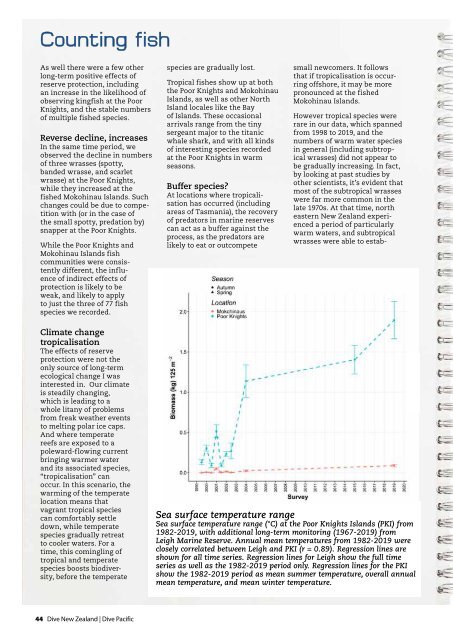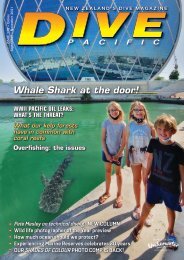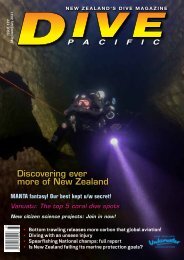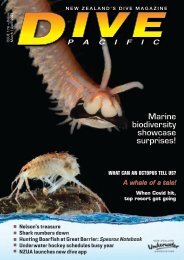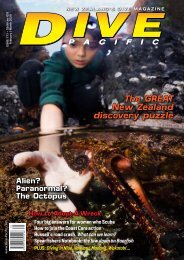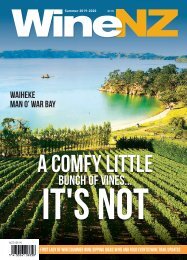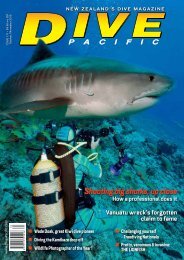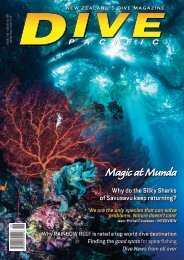Dive Pacific 175 Dec2020 Jan 2021
Dive Pacific, New Zealand's Dive Magazine , captures the best of diving in New Zealand and the Pacific. with adventures, top photos and expert technical advice
Dive Pacific, New Zealand's Dive Magazine , captures the best of diving in New Zealand and the Pacific. with adventures, top photos and expert technical advice
You also want an ePaper? Increase the reach of your titles
YUMPU automatically turns print PDFs into web optimized ePapers that Google loves.
Counting fish<br />
As well there were a few other<br />
long-term positive effects of<br />
reserve protection, including<br />
an increase in the likelihood of<br />
observing kingfish at the Poor<br />
Knights, and the stable numbers<br />
of multiple fished species.<br />
Reverse decline, increases<br />
In the same time period, we<br />
observed the decline in numbers<br />
of three wrasses (spotty,<br />
banded wrasse, and scarlet<br />
wrasse) at the Poor Knights,<br />
while they increased at the<br />
fished Mokohinau Islands. Such<br />
changes could be due to competition<br />
with (or in the case of<br />
the small spotty, predation by)<br />
snapper at the Poor Knights.<br />
While the Poor Knights and<br />
Mokohinau Islands fish<br />
communities were consistently<br />
different, the influence<br />
of indirect effects of<br />
protection is likely to be<br />
weak, and likely to apply<br />
to just the three of 77 fish<br />
species we recorded.<br />
species are gradually lost.<br />
Tropical fishes show up at both<br />
the Poor Knights and Mokohinau<br />
Islands, as well as other North<br />
Island locales like the Bay<br />
of Islands. These occasional<br />
arrivals range from the tiny<br />
sergeant major to the titanic<br />
whale shark, and with all kinds<br />
of interesting species recorded<br />
at the Poor Knights in warm<br />
seasons.<br />
Buffer species?<br />
At locations where tropicalisation<br />
has occurred (including<br />
areas of Tasmania), the recovery<br />
of predators in marine reserves<br />
can act as a buffer against the<br />
process, as the predators are<br />
likely to eat or outcompete<br />
small newcomers. It follows<br />
that if tropicalisation is occurring<br />
offshore, it may be more<br />
pronounced at the fished<br />
Mokohinau Islands.<br />
However tropical species were<br />
rare in our data, which spanned<br />
from 1998 to 2019, and the<br />
numbers of warm water species<br />
in general (including subtropical<br />
wrasses) did not appear to<br />
be gradually increasing. In fact,<br />
by looking at past studies by<br />
other scientists, it’s evident that<br />
most of the subtropical wrasses<br />
were far more common in the<br />
late 1970s. At that time, north<br />
eastern New Zealand experienced<br />
a period of particularly<br />
warm waters, and subtropical<br />
wrasses were able to estab-<br />
Climate change<br />
tropicalisation<br />
The effects of reserve<br />
protection were not the<br />
only source of long-term<br />
ecological change I was<br />
interested in. Our climate<br />
is steadily changing,<br />
which is leading to a<br />
whole litany of problems<br />
from freak weather events<br />
to melting polar ice caps.<br />
And where temperate<br />
reefs are exposed to a<br />
poleward-flowing current<br />
bringing warmer water<br />
and its associated species,<br />
“tropicalisation” can<br />
occur. In this scenario, the<br />
warming of the temperate<br />
location means that<br />
vagrant tropical species<br />
can comfortably settle<br />
down, while temperate<br />
species gradually retreat<br />
to cooler waters. For a<br />
time, this comingling of<br />
tropical and temperate<br />
species boosts biodiversity,<br />
before the temperate<br />
Sea surface temperature range<br />
Sea surface temperature range (°C) at the Poor Knights Islands (PKI) from<br />
1982-2019, with additional long-term monitoring (1967-2019) from<br />
Leigh Marine Reserve. Annual mean temperatures from 1982-2019 were<br />
closely correlated between Leigh and PKI (r = 0.89). Regression lines are<br />
shown for all time series. Regression lines for Leigh show the full time<br />
series as well as the 1982-2019 period only. Regression lines for the PKI<br />
show the 1982-2019 period as mean summer temperature, overall annual<br />
mean temperature, and mean winter temperature.<br />
44 <strong>Dive</strong> New Zealand | <strong>Dive</strong> <strong>Pacific</strong>


